Zeugma Mosaic Museum
2026-01-09

The Gypsy Girl Mosaic
Zeugma Mosaic Museum in Gaziantep, Turkey, is the perfect gateway to immerse yourself in ancient history and captivating mythology. Renowned as one of the largest mosaic museums worldwide, the Zeugma Mosaic Museum is celebrated for its exceptional collection of Roman and Late Antique mosaics from the illustrious ancient city of Zeugma. Opened in 2011, this museum spans an impressive 30,000 square meters, prominently featuring 2,448 square meters of beautifully preserved mosaics.
Among its most famous treasures is the mesmerizing "Gypsy Girl" mosaic, discovered during rescue excavations in 1998. Distinguished by its haunting, expressive eyes, this iconic piece embodies Zeugma's sophisticated artistry, reflecting the vibrant cultural tapestry of the Euphrates region. The enigmatic figure, crafted meticulously with stone and glass tesserae, draws parallels to masterpieces like da Vinci’s Mona Lisa due to her captivating gaze, which appears to follow visitors throughout the exhibit.
Explore galleries filled with extraordinary mosaics such as "Oceanus and Tethys," depicting grand mythological scenes, and "Achilles Revealed," highlighting intricate narratives from Greek mythology. Witness the depiction of divine romance through "Zeus and Europa" and admire the poetic beauty captured in the "Orpheus Mosaic." Each artifact at the Zeugma Mosaic Museum offers profound insights into daily life, beliefs, and the unparalleled artistic achievements of civilizations dating back centuries.
The Zeugma Mosaic Museum recreates ancient streets, fountains, and luxurious villa walls, immersing visitors in the authentic ambiance of Roman-era Zeugma. This evocative setting bridges the past with the present, transforming your visit into a memorable historical journey.
Enhance your experience of visiting the Zeugma Mosaic Museum with our private transfers. and car and driver rental services. Enjoy comfortable, reliable journeys, connecting seamlessly between Istanbul and Gaziantep's archaeological marvels.
Zeugma Museum
Zeugma Museum Turkey
Zeugma Ancient City: Zeugmam stands as a beacon for history aficionados, art enthusiasts, and archaeologists alike. A jewel in Turkey's cultural crown, the museum's vast collection of mosaics showcases the zenith of artistic prowess and serves as a compelling reason for many to venture to this land. Recognized as one of the most expansive mosaic museums globally, both in architectural expanse and the mosaic-covered area, it offers visitors a glimpse into the artistic sensibilities of ancient civilizations. Beyond the mosaics, the Late Antiquity churches and the traces of Early Syriac and Christian iconography further enrich the museum's allure.
Zeugma Mosaics
The grandeur of the Zeugma Mosaic Museum extends beyond its iconic mosaics. Covering an impressive 2,500 square meters,the museum showcases some of the most significant archaeological discoveries of modern times. In addition to the captivating mosaics, Zeugma houses a diverse collection of Roman-era artifacts, including statues, intricately carved columns, and ornate fountains. Among the highlights is the bronze statue of Ares, the God of War, celebrated for its exceptional craftsmanship and detailed artistry.
Situated between the historic Tigris and Euphrates rivers—the cradle of Mesopotamian civilization—the region has flourished for thousands of years. Approximately 2,300 years ago, Seleukos Nikator, a general under Alexander the Great, embarked on expansive conquests across Anatolia. Drawn to the fertile banks of the Euphrates, he established a settlement he named Seleucus Euphrates, honoring both the river and his own heritage. When the Romans took control in 64 BC, the settlement's name transitioned to 'Zeugma,' meaning 'bridgehead.' This new designation highlighted Zeugma's pivotal role as a hub connecting various cultures, civilizations, and trade routes. Over the centuries, Zeugma rose to prominence as one of the leading cities within the Kingdom of Commagene, until its eventual decline following invasions by the Sassanid Empire.
The Gypsy Girl Mosaic
One of the museum's most celebrated masterpieces is the Gypsy Girl Zeugma Mosaic, a captivating artifact discovered in 1998 during rescue excavations at the ancient city of Zeugma. This 2nd-century AD Roman mosaic fragment was unearthed beneath a fallen column in the dining room (triclinium) of the Maenad Villa. Although small, measuring roughly 30 by 30 centimeters, the mosaic portrays a figure with large, expressive eyes gazing enigmatically in a three-quarter perspective, characteristic of Hellenistic art. Crafted meticulously from tiny glass and stone tesserae, the mosaic reflects the subtle hues of the Euphrates landscape, exhibiting the exceptional skill of Zeugma artisans.
Originally part of a larger composition, the mosaic suffered fragmentation due to illegal excavations in the 1960s, with several pieces lost abroad. After decades of diplomatic efforts, Turkey successfully repatriated twelve stolen fragments from the United States in 2018. Reunited with the original piece, the completed mosaic is displayed in a dedicated, dimly lit room within the museum, where its mystique is amplified by atmospheric music.
Situated between the historic Tigris and Euphrates rivers—the cradle of Mesopotamian civilization—the region has flourished for millennia. Around 2,300 years ago, Seleukos Nikator, a general under Alexander the Great, established a settlement named Seleucus Euphrates along the fertile banks of the Euphrates. Under Roman rule from 64 BC, the settlement became known as 'Zeugma,' symbolizing its strategic role as a crossroads connecting cultures, civilizations, and trade routes. Throughout its history, Zeugma thrived as a prominent city within the Kingdom of Commagene, until its decline following invasions by the Sassanid Empire.
Gypsy Girl Mosaic
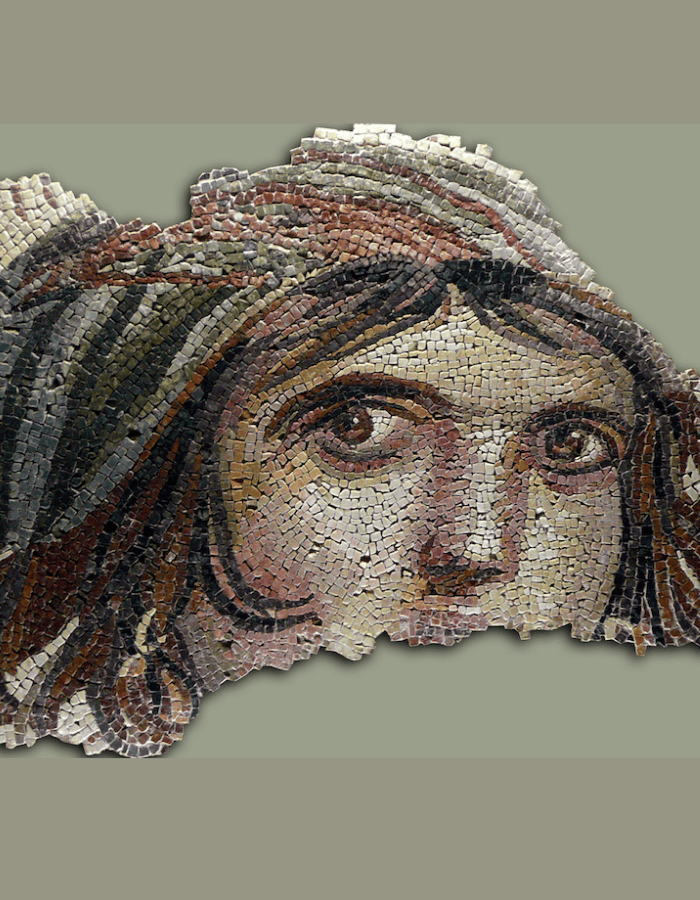
Oceanus and Tethys Mosaic
Oceanus and Tethys: A Mesmerizing Mosaic of the Roman Imperial Period at Zeugma
Beneath the shimmering waters of a pool in the Zeugma Mosaic Museum, a captivating relic from the Roman Imperial Period awaits discovery: The Oceanus and Tethys Mosaic. A testament to ancient artistry, this mosaic captures the essence of Oceanus, revered as the life-giving god of the ocean, and his consort, Tethys. The duo gracefully dominates the mosaic's center, ensconced within three intricately braided borders. Surrounding them, various fish species and depictions of Eros astride dolphins evoke the boundless bounty of the oceanic realm. Oceanus stands out with his symbolic attributes of snakes and fish.
A distinctive trait of Oceanus is the crab claws adorning his head. Interestingly, in some artifacts, Oceanus is illustrated with an eel tail in lieu of feet. Beside him, Tethys is elegantly portrayed, bearing wings upon her forehead. (Some interpretations also liken her to the hawk figure in mythology.) Between the pair slithers Ketos, a mythological sea creature with a serpentine body resembling a dragon. This very dragon motif is emblematic of Zeugma and even graces coins minted in the city's name. Zeugma's proximity to the Euphrates might be the inspiration behind its dragon association.
On the upper right quadrant of the mosaic, a youthful figure, possibly Pan – the guardian of shepherds, sits atop a rock engrossed in fishing. The peripheral representations of Eros and Pan suggest the pool's welcoming nature, possibly a locale for visitors.
In the annals of mythology, Oceanus stands as one of Gaia's twelve titanic offspring. Rather than being viewed as a vast ocean, he embodies the concept of a perpetually flowing universal river – the primordial source of all rivers, often visualized as a whirlpool.
Oceanus - Tethys
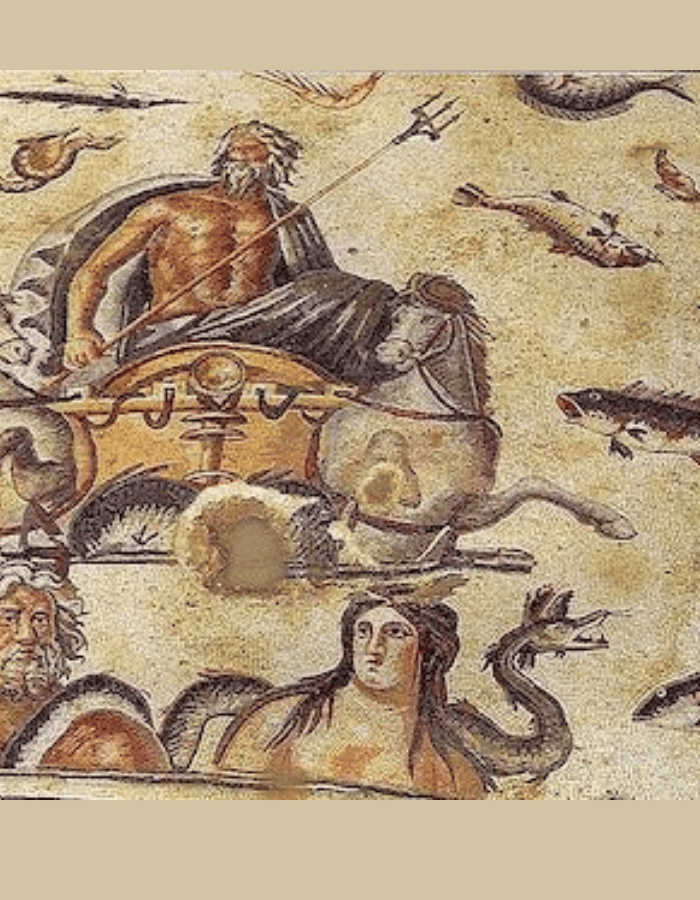
The Akratos and Euphrosine Mosaic
The Akratos and Euphrosine Mosaic, this intricate floor mosaic once graced the room of Menad. In the Zeugma Mosaic Museum, next door to the famous Gypsy Girl mosaic, is another masterpiece that tells the story of divine ritual and joyful celebration.
The tableau vividly captures Akratos – whose name symbolizes a "manager" or "giver" – presenting the sacred wine, drawn from a divine reservoir, to Euphrosine. Her name, which translates to "bringer of joy", resonates deeply in this depiction. He offers this holy elixir in a radiant golden crater, using the horn of fertility, embodying both abundance and reverence. To the right, Euphrosine is beautifully rendered, reclining languidly beneath a tree, epitomizing pleasure and tranquility. The nuanced postures and expressions of these figures speak volumes of the serenity and delight they embody. Adding further layers of symbolism, a prominently illustrated bell to the mosaic's left not only accentuates the festivity and the wine's significance but also hints at a sense of sacredness, weaving an intricate tapestry of celebration and reverence.
Akratos and Euphrosine
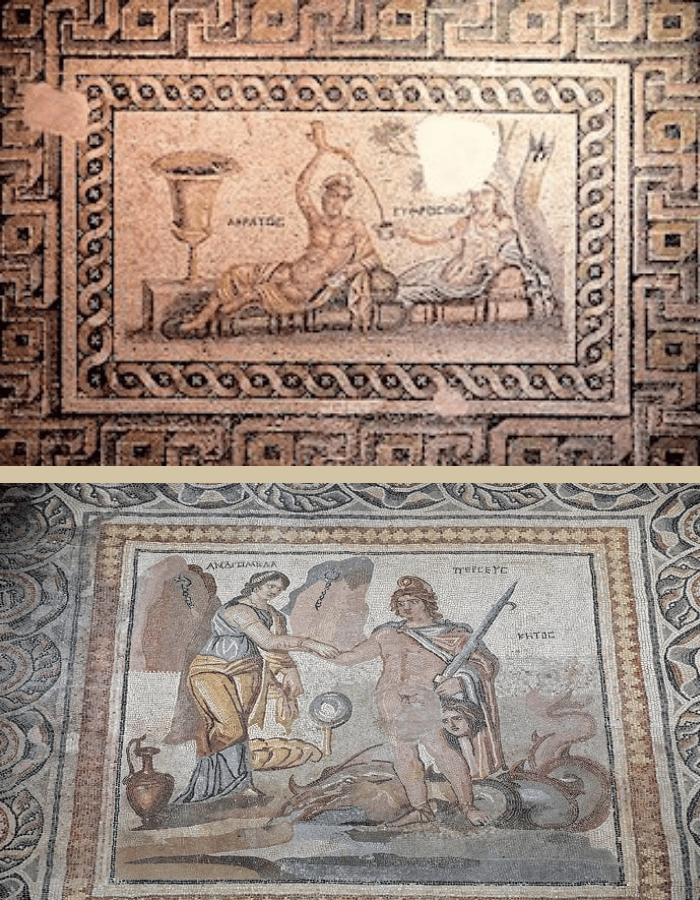
Ancient Greek Mosaic
Achilles stands as one of the towering figures of Greek mythology. Born to Peleus and Thetis, a tale recounts how Thetis, in an attempt to immortalize her son, gripped him by the heel and submerged him into the river Styx. Every part of Achilles turned invincible, save for his exposed heel. Hence, no weapon could harm him, except when aimed at this vulnerable spot. Another version of the myth shares how Thetis bestowed blessings upon Achilles by immersing him in fire, further alluding to his indomitable spirit. Raised on a mountain by the wise Chiron, Achilles matured into a young man unparalleled in skills and prowess.
Many might recall from cinematic portrayals, such as in "Troy", how crucial Achilles was to the Achaean-Trojan conflict. The oracle pronounced that without Achilles, victory in the Trojan War would remain elusive. Fearing her son's prophesied demise, Thetis sent Achilles into hiding on the island of Skyros, within King Lykomedes' palace. There, amidst Lykomedes' harem, Achilles became enamored with a red-haired maiden, resulting in the birth of a son, Neoptolemos.
Odysseus, acting on the prophecy, embarks on a quest for Achilles. Disguised as a merchant, he reaches Skyros and cunningly exposes Achilles' true identity by tempting him with exquisite weapons. Once revealed, Odysseus convinces Achilles to join the Achaean forces. Alas, on the battlefield, a single arrow from Paris finds Achilles' heel, ending the life of this legendary warrior.
This captivating mosaic celebrates the pivotal moment when Achilles' identity is unveiled. Crafted with precision, the figures, progressing from left to right in an untraditional manner, impart dynamism to the scene. The wave motifs encircling the mosaic enhance its visual allure, especially when the pool it adorns is brimming with water. As an artifact from the 2nd century AD, this mosaic not only immortalizes Achilles' myth but also the artistry of the epoch in which it was created.
Achilles Mosaic

Zeus and Europhe Mosaic
In a vivid tableau within the Zeugma Ancient City, we witness the mesmerizing tale of Zeus, the paramount god of Olympus, and his captivation with Europhe, the daughter of the Phoenician King. Legend tells of Zeus's enamorment, which led him to assume the form of a majestic bull and approach Europhe while she reveled by the sea. Unaware of the deity's disguise, she was drawn to the gentle creature, adorning its horns with blossoms and daring to climb atop its back. But as soon as she settled, the bull – Zeus in his concealed form – surged forth with haste, prompting Europhe to grip him tightly.
The mosaic captures this charged moment with palpable dynamism: the bull's powerful stride, the ripples in the water signified by the fish, and Europhe's attempt to shield her garments from the splash. Accompanying her, a companion is portrayed on a winged panther, their contrasting directions symbolizing the impending abduction. The artwork masterfully interweaves myth and artistry, ensnaring viewers in its tale of divine intrigue.
Old Roman Mosaics
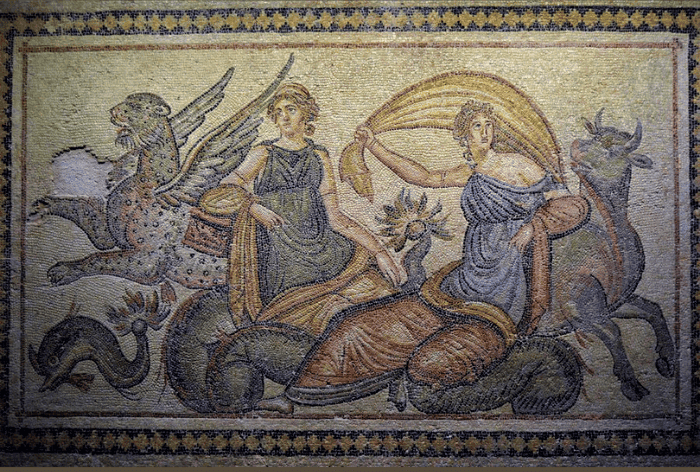
Ancient Mosaics
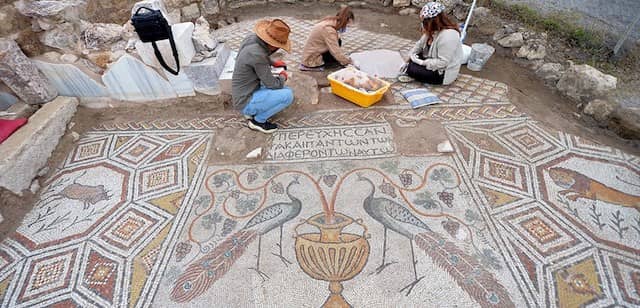
Historical Mosaics
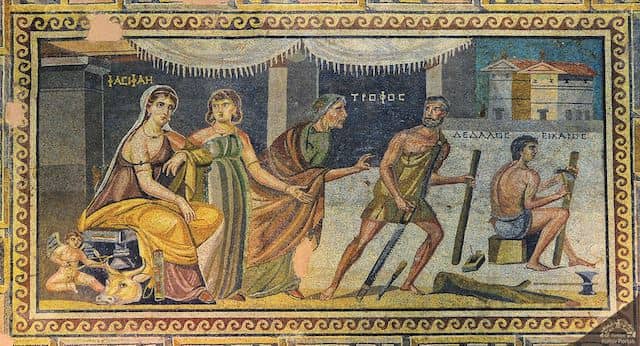
Zeugma Mosaic Museum Working Hours
The Zeugma Mosaic Museum in Gaziantep is open daily, providing flexible visiting options for travelers. As of the latest update, it operates from 08:30 AM to 10:00 PM, with final admissions at 9:30 PM. This extended schedule allows visitors to explore the museum at their preferred pace, whether in the morning or later in the evening. Keep in mind that hours may occasionally change due to special events, renovations, or seasonal adjustments. For example, in August 2022, the museum temporarily extended its closing time to 10:00 PM to accommodate increased visitor numbers. To avoid surprises, always check the museum’s official website or call ahead before your visit.
Entry Prices (as of March 2025)
- Zeugma Mosaic Museum: €12 (Museum Pass valid)
- Zeugma Archaeological Site: €5 (Museum Pass valid)
Please note that prices may increase due to inflation and changing tourism policies. Recent trends suggest that the museum entry could rise to €15–€18 for foreign visitors, with similar adjustments for locals paying in Turkish Lira (TRY). The Museum Pass Turkey remains a cost-effective option for those planning to visit multiple sites.
Tips for Visiting
To avoid crowds, plan your visit early in the morning or during the late evening hours, especially in peak seasons like spring and fall. Weekdays are generally quieter than weekends. Guided tours are available and highly recommended for deeper historical context. Interactive and digital exhibits also add value but may require additional time to explore. Photography is permitted in most areas, though restrictions may apply in specific sections—look out for signs.

Write a Comment !